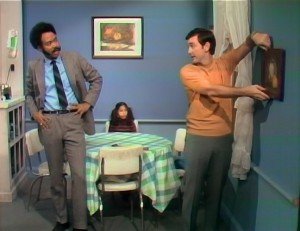Sesame Street Ep #1
Once that’s done, we’re back in Gordon’s house, where Bob–who is still a shop teacher here–is helping Gordon hang a still life of fruit that he painted, and taking advice from Bob, Sally, and then eventually Susan as to the best spot on the wall to put it, which I guess teaches something about placement and orientation or some such? We then cut to the Buddy and Jim film from the pilot, which I skipped through this time around, because life is too short to sit through that twice.
And when we’re back from that tedium, Bob, Gordon, and Sally are sitting at a table, now randomly joined by Kermit! No introduction. He’s just there, sitting on the table in classic frog pose, his appearance pretty indicative of the thrown-together feel of the show at this point. You’d think they might want to establish his entrance or his character, but I guess just the fact that he was known in pop culture at that point and that this was thought of as more of a compilation/variety show than a narrative meant introducing him wasn’t deemed necessary? Anyway, Bob folds a dollar bill into the letter “W,” which sends us off to the cartoon of Wanda the Witch, a Sesame Street short I remember fondly from childhood, and then to a Kermit sketch, in which he lectures on the letter W.
What’s awesome about this sketch is that it directly takes off on the classic Kermit-performs-while-a-monster-approaches-him-from-behind sorts of comedy bits that Jim had been doing since Sam and Friends, but here towards an educational–albeit no less comedic–end. Kermit sits next to a foam “W,” and starts listing “W” words, such as wash, woman, and weeping willow, but unbeknownst to him, Cookie Monster has appeared behind him and begun to devour the letter, tearing off the line furthest to the left, leaving a slightly askew “N”. And so Kermit, not missing a beat, instantly transitions into “N” words, like “nice,” “nifty,” and “nincompoop,” until Cookie tears off the next line, leaving a “V,” and Kermit continues from there, my favorite of his “v” words being “very confused”.
Finally, there’s just a tilted “I,” or the number “1,” as the increasingly frazzled frog explains. And once the letter is totally gone, Cookie starts approaching Kermit, trying to fit one of his legs in his mouth. In an old sketch, he probably would have eaten him. However, here, Kermit tricks him by saying he thinks he hears Cookie’s mom calling, throwing him off his game, and giving our intrepid frog time to escape.
A few things: first off, I love how Jim retains the edge of his original comedy here. Rather than worry that a hungry monster might frighten children, he trusts them to deal with it. The only “concession” is that Kermit doesn’t get eaten, and the way he does it is actually very clever, because by establishing that the monster has a “mommy” too, it helps the audience see him as a kid like they are, establishing that even people who don’t look like you, and even other “scary” things like some ferocious animals have parents, thus creating empathy. The other thing is, although I call him Cookie, he’s still not Cookie yet. He’s a monster who seems to eat everything in sight indiscriminately. He’s pretty much exactly as he was in the Munchos commercials, having lost the fangs from his earliest appearances. Apparently, it wasn’t until a classic sketch in which he eats cookies that Ernie left out that this crucial part of his personality would fall into place.
And after a brief intermission with a “W is for Worm” cartoon, we return with Kermit and yet another foam “W,” however rather than being the victim of a vicious monster attack, this W is the one who will do the attacking! As Kermit starts listing various W words this time around, the W illustrates them by doing exactly what Kermit says. He says “wiggle,” the W wiggles, “wobble,” it wobbles, “walk,” it walks, etc. but soon it starts to get out of control, performing actions before Kermit can say them, causing Kermit to react with W words. Eventually, it pounces on him, Kermit fighting it off while yelping out words and phrases like “wait a minute,” “watch it,” “wrestle,” “whack,” “warning,” “war,” “winning,” and “weakening”. Unfortunately, by this point, he’s describing himself rather than the W! It ends with a “Woe is me,” as the W triumphantly jumps on his poor froggy head.
And then as the episode starts to wrap up, Susan treats us to the very first rendition of “One of These Things is Not Like the Others,” something else I was surprised and delighted to see appear so early on in the run, although the song isn’t yet in its final form, feeling a bit rough around the edges, especially at the end. And then, we have a brief little wrap-up where Gordon reminds us of everything that happened that day, Susan gifts a still-weeping Ernie with a foam 2, and Mr. Hooper tells us that today’s episode of Sesame Street was sponsored by the letter “W” and the number, “2”.
As I mentioned before, Sesame Street became a huge hit almost immediately, and it’s not hard to see why it would have been so appealing, even in this early, not-yet-fully-polished state. I wouldn’t yet at this stage consider it a show that an adult could enjoy just as much as a child, as would happen later, but the potential is there. There are some very funny bits here, particularly those last two Kermit ones, and many of the lessons throughout are obscured well enough to not feel like just watching a class for children. At the same time, neither the humor nor the show’s presentation and format have the sophistication they would later gain. But, particularly for someone who grew up with the show’s later years, its origins continue to be fascinating to observe.
And on Monday, we jump ahead to Episode #56!



